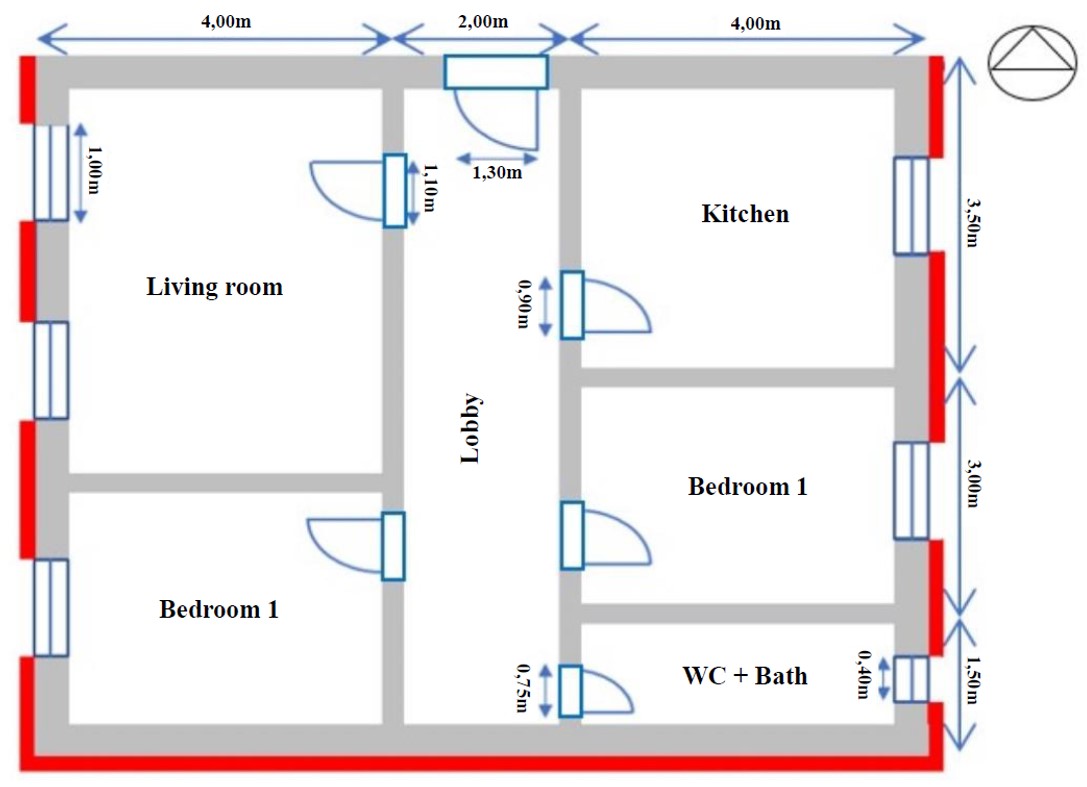Multi criteria study of thermal insulation techniques based on natural insulators for exterior walls of buildings
Main Article Content
Abstract
The objective of this paper is to propose different solutions and techniques for local residential constructions in desert regions characterized by a hot and arid climate. These solutions aim to solve the problem of thermal discomfort of the occupants during winter and summer, and to minimize energy loads due to heating and cooling systems. This can lead to significant long-term annual energy savings. To achieve this goal, three conventional external thermal insulation (ETI) systems for opaque walls based on natural insulators (hemp fiber and sheep wool) under different techniques (under coating, under cladding, and a combination of the two insulators) were selected. The evaluation and study of these ETI systems was carried out using "TRNSYS" software. A technical-economic study was also carried out for all the systems tested, in order to determine the actual savings achieved. The results obtained show that the combined insulation system (hemp fiber and sheep wool) is the best performing solution among the proposed systems, with an average cost.
Article Details

This work is licensed under a Creative Commons Attribution-NonCommercial-NoDerivatives 4.0 International License.
This work is licensed under a Creative Commons Attribution-NonCommercial-NoDerivatives 4.0 International License.
References
Bloch-Lainé JM. Practical guide to thermal insulation in buildings. France: Eyrolles; 1977.
Fragos MM, Trouillez. The insulation guide: better understanding to choose well [Internet]. Paris: Fine Media; 2012 [cited 2023 Jan 3]. Available from: https://www.yumpu.com/fr/document/read/19826396/le-guide-de-lisolation. (In French)
Ziad S, Benoudjafer I, Benoudjafer I. Does the shared vision of social identities influence the quality of civil construction by reinforcing the type of thermal insulation, and by creating or improving thermal comfort?. Technium Social Sciences Journal. 2023;40(1):366-77.
Benoudjafer IB. Energy certification as a sustainable strategy. Case of the city of Bechar [thesis]. Biskra: University of Mohamed Khider; 2018.
Benoudjafer I, Ghomari F, Mokhtari A. Comparative study on the energy efficiency of two appartments in Bechar. Revue des Energies Renouvelables. 2012;15(1):1-12. (In French)
Benoudjafer I, Zemmouri N, Benoudjafer I. Study of energy performance improvements in dry and hot climate residential buildings. Courrier du Savoir. 2018;26:245-58. (In French)
Benoudjafer I, Benoudjafer I. Innovation Façade for energy performance and thermal comfort of buildings in hot and dry climate. J Fundam Appl Sci. 2020;12(3):1350 -65.
Durakovic B, Yildiz G, Yahia ME. Comparative performance evaluation of conventional and renewable thermal insulation materials used in building envelops. Technical Gazette. 2020;27(1):283-9.
Wahlström MH, Harsman B. Residential energy consumption and conservation. Energy Build. 2015;102:58-66.
Taleghani M, Tenpierik M, Kurvers S, van den Dobbelsteen A. A review into thermal comfort in buildings. Renew Sust Energ Rev. 2013;26:201-15.
Sekhar SC. Thermal comfort in air-conditioned buildings in hot and humid climates - why are we not getting it right?. Indoor Air. 2016;26(1):138-52.
Alghamdi S, Tang W, Kanjanabootra S, Alterman D. Effect of architectural building design parameters on thermal comfort and energy consumption in higher education buildings. Buildings. 2022;12(3):1-29.
Bendouma M. Externel thermal insulation systems: experimental and numerical studies of heat and humidity transfers [Internet]. French: University of South Brittany; 2018 [cited 2021 Apr 13]. Available from: https://tel.archives-ouvertes.fr/tel-01975115. (In French)
Ducoulombier LW. Design of a new exterior insulation system for the building [Internet]. French: Central School of Lille; 2014 [cited 2021 Apr 13]. Available from: https://tel.archives-ouvertes.fr/tel-02372099. (In French)
Elmzughi M, Alghoul S, Mashena M. Optimizing thermal insulation of external building walls in different climate zones in Libya. J Build Phys. 2021;45(3):368-90.
Abu-Jdayil B, Mourad AH, Hittini W, Hassan M, Hameedi S. Traditional, state-of-the-art and renewable thermal building insulation materials: an overview. Constr Build Mater. 2019;214:709-35.
Oushabi A, Sair S, Abboud Y, Tanane O, El Bouari A. Natural thermal-insulation materials composed of renewable resources: characterization of local date palm fibers (LDPF). J Mater Environ Sci. 2015;6(12):3395-402.
Zach J, Korjenic A, Petranek V, Hroudova J, Bednar T. Performance evaluation and research of alternative thermal insulations based on sheep wool. Energy Build. 2012;49:246-53.
Hegyi A, Bulacu C, Szilagyi H, Lazarescu AV, Meita V, Vzureanu P , et al. Improving indoor air quality by using sheep wool thermal insulation. Materials (Basel). 2021;14(9):1-14.
Kosinski P, Brzyski P, Szewczyk A, Motacki W. Thermal properties of raw hemp fiber as a loose-fill insulation material. J Nat Fibers. 2018;15(5):717-30.
Pennacchio R, Savio L, Bosia D, Thiebat F, Piccablotto G, Patrucco A, et al. Fitness: sheep-wool and hemp sustainable insulation panels. Energy Procedia. 2017;111:287-97.
Zach J, Korjenic A, Petránek V, Hroudová J, Bednar T. Performance evaluation and research of alternative thermal insulations based on sheep wool. Energy Build. 2012;49:246-53.
Gaujena B, Agapovs V, Borodinecs A, Strelets K. Analysis of thermal parameters of hemp fiber insulation. Energies. 2020;13(23):1-14.
Wikipedia. Bechar [Internet]. 2022 [cited 2022 Oct 3]. Available from: https: //Fr.wikipédia.org/wiki/Bechar.
Lakatos Á, Kalmár F. Investigation of thickness and density dependence of thermal conductivity of expanded polystyrene insulation materials. Mater Struct. 2013;46(7):1101-5.
Sahu DK, Sen PK, Sahu G, Sharma R, Bohidar S. A review on thermal insulation and its optimum thickness to reduce heat loss. Int J Innov Res Sci Technol. 2015;2(6):1-6.
Asdrubali F, D’Alessandro F, Schiavoni S. A review of unconventional sustainable building insulation materials. Sustain Mater Technol. 2015;4:1-17.
Effy.fr [Internet]. 2022 [cited 2022 Nov 1]. Available from: https://www.effy.fr/travaux-energetique/isolation/isolation-murs/par-l-exterieur/prix. (In French)



